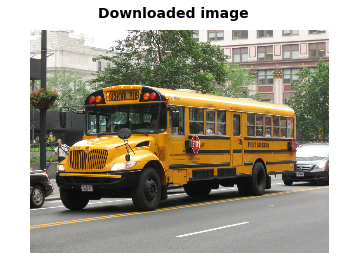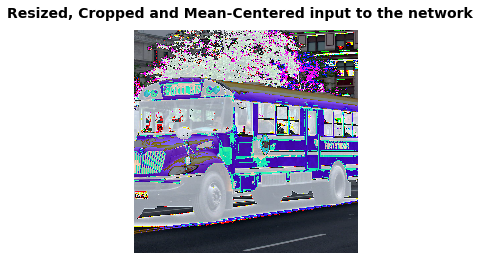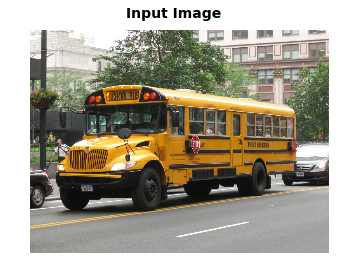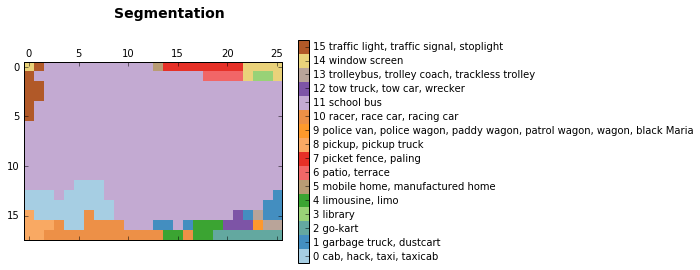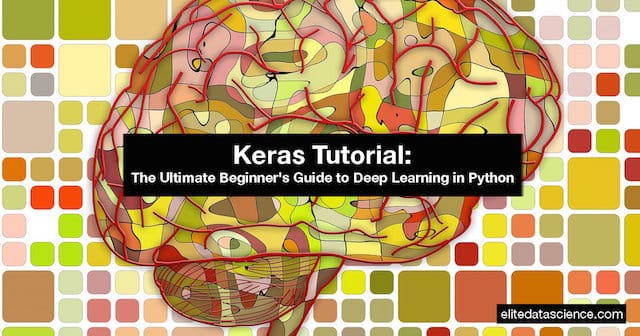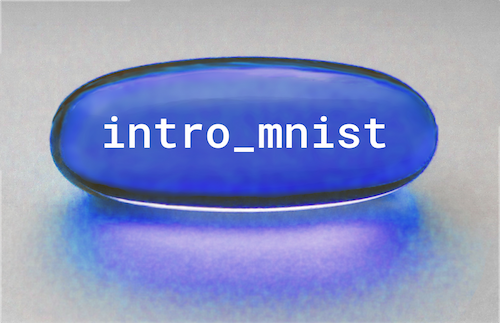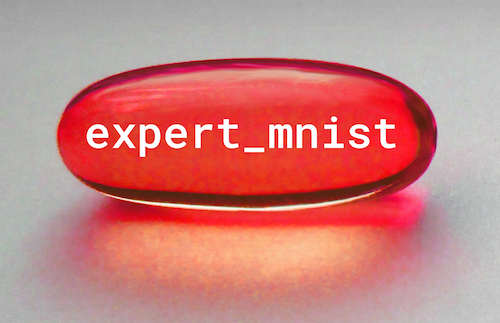https://elitedatascience.com/keras-tutorial-deep-learning-in-python
In this step-by-step Keras tutorial, you’ll learn how to build a convolutional neural network in Python!
In fact, we’ll be training a classifier for handwritten digits that boasts over 99% accuracy on the famous MNIST dataset.
Before we begin, we should note that this guide is geared toward beginners who are interested in applied deep learning.
Our goal is to introduce you to one of the most popular and powerful libraries for building neural networks in Python. That means we’ll brush over much of the theory and math, but we’ll also point you to great resources for learning those.
Before we start...
Recommended Prerequisites
The recommended prerequisites for this guide are:
To move quickly, we'll assume you have this background.
Why Keras?
Keras is our recommended library for deep learning in Python, especially for beginners. Its minimalistic, modular approach makes it a breeze to get deep neural networks up and running. You can read more about it here:
WTF is Deep Learning?
Deep learning refers to neural networks with multiple hidden layers that can learn increasingly abstract representations of the input data. This is obviously an oversimplification, but it's a practical definition for us right now.
For example, deep learning has led to major advances in computer vision. We're now able to classify images, find objects in them, and even label them with captions. To do so, deep neural networks with many hidden layers can sequentially learn more complex features from the raw input image:
- The first hidden layers might only learn local edge patterns.
- Then, each subsequent layer (or filter) learns more complex representations.
- Finally, the last layer can classify the image as a cat or kangaroo.
These types of deep neural networks are called Convolutional Neural Networks.
WTF are Convolutional Neural Networks?
In a nutshell, Convolutional Neural Networks (CNN's) are multi-layer neural networks (sometimes up to 17 or more layers) that assume the input data to be images.

Typical CNN Architecture
By making this requirement, CNN's can drastically reduce the number of parameters that need to be tuned. Therefore, CNN's can efficiently handle the high dimensionality of raw images.
Their underlying mechanics are beyond the scope of this tutorial, but you can read more about them here.
What this tutorial is not:
This is not a complete course on deep learning. Instead, this tutorial is meant to get you from zero to your first Convolutional Neural Network with as little headache as possible!
If you're interested in mastering the theory behind deep learning, we recommend this great course from Stanford:
A quick tip before we begin:
We tried to make this tutorial as streamlined as possible, which means we won't go into too much detail for any one topic. It's helpful to have the Keras documentation open beside you, in case you want to learn more about a function or module.
Keras Tutorial Contents
Here are the steps for building your first CNN using Keras:
- Set up your environment.
- Install Keras.
- Import libraries and modules.
- Load image data from MNIST.
- Preprocess input data for Keras.
- Preprocess class labels for Keras.
- Define model architecture.
- Compile model.
- Fit model on training data.
- Evaluate model on test data.
Step 1: Set up your environment.
First, hang up a motivational poster:

Probably useless.
Next, make sure you have the following installed on your computer:
- Python 2.7+ (Python 3 is fine too, but Python 2.7 is still more popular for data science overall)
- SciPy with NumPy
- Matplotlib (Optional, recommended for exploratory analysis)
- Theano* (Installation instructions)
We strongly recommend installing Python, NumPy, SciPy, and matplotlib through the Anaconda Distribution. It comes with all of those packages.
*note: TensorFlow is also supported (as an alternative to Theano), but we stick with Theano to keep it simple. The main difference is that you'll need to reshape the data slightly differently before feeding it to your network.
You can check to see if you've installed everything correctly:
Go to your command line program (Terminal on a Mac) and type in:
You'll see the Python interpreter:
|
|
Python 2.7.12 |Anaconda 4.0.0 (x86_64)| (default, Jul 2 2016, 17:43:17) |
Next, you can import your libraries and print their versions:
|
|
>>> import numpy
>>> import theano
>>> print numpy.__version__
1.11.0
>>> print theano.__version__
0.8.2
>>> quit() |
Step 2: Install Keras.
It wouldn't be a Keras tutorial if we didn't cover how to install Keras.
The good news is that if you used Anaconda, then you'll already have a nice package management system called pip installed.
You can confirm you have it installed by typing $ pip in your command line. It should output a list of commands and options. If you don't have pip, you can install it here.
Once you have pip, installing Keras is easy as pie:
You can confirm it's installed correctly:
|
|
$ python -c "import keras; print keras.__version__"
Using Theano backend.
1.0.4 |
Oops... looks like that Keras version is outdated. Upgrading the version is easy:
|
|
$ pip install --upgrade keras
...
$ python -c "import keras; print keras.__version__"
Using Theano backend.
1.1.1 |
Perfect, now let's start a new Python file and name it keras_cnn_example.py.
Step 3: Import libraries and modules.
Let's start by importing numpy and setting a seed for the computer's pseudorandom number generator. This allows us to reproduce the results from our script:
|
|
import numpy as np
np.random.seed(123) # for reproducibility |
Next, we'll import the Sequential model type from Keras. This is simply a linear stack of neural network layers, and it's perfect for the type of feed-forward CNN we're building in this tutorial.
|
|
from keras.models import Sequential |
Next, let's import the "core" layers from Keras. These are the layers that are used in almost any neural network:
|
|
from keras.layers import Dense, Dropout, Activation, Flatten |
Then, we'll import the CNN layers from Keras. These are the convolutional layers that will help us efficiently train on image data:
|
|
from keras.layers import Convolution2D, MaxPooling2D |
Finally, we'll import some utilities. This will help us transform our data later:
|
|
from keras.utils import np_utils |
Now we have everything we need to build our neural network architecture.
Step 4: Load image data from MNIST.
MNIST is a great dataset for getting started with deep learning and computer vision. It's a big enough challenge to warrant neural networks, but it's manageable on a single computer. We discuss it more in our post: 6 Fun Machine Learning Projects for Beginners.
The Keras library conveniently includes it already. We can load it like so:
|
|
from keras.datasets import mnist
# Load pre-shuffled MNIST data into train and test sets
(X_train, y_train), (X_test, y_test) = mnist.load_data() |
We can look at the shape of the dataset:
|
|
print X_train.shape
# (60000, 28, 28) |
Great, so it appears that we have 60,000 samples in our training set, and the images are 28 pixels x 28 pixels each. We can confirm this by plotting the first sample in matplotlib:
|
|
from matplotlib import pyplot as plt
plt.imshow(X_train[0]) |
And here's the image output:
In general, when working with computer vision, it's helpful to visually plot the data before doing any algorithm work. It's a quick sanity check that can prevent easily avoidable mistakes (such as misinterpreting the data dimensions).
Step 5: Preprocess input data for Keras.
When using the Theano backend, you must explicitly declare a dimension for the depth of the input image. For example, a full-color image with all 3 RGB channels will have a depth of 3.
Our MNIST images only have a depth of 1, but we must explicitly declare that.
In other words, we want to transform our dataset from having shape (n, width, height) to (n, depth, width, height).
Here's how we can do that easily:
|
|
X_train = X_train.reshape(X_train.shape[0], 1, 28, 28)
X_test = X_test.reshape(X_test.shape[0], 1, 28, 28) |
To confirm, we can print X_train's dimensions again:
|
|
print X_train.shape
# (60000, 1, 28, 28) |
The final preprocessing step for the input data is to convert our data type to float32 and normalize our data values to the range [0, 1].
|
|
X_train = X_train.astype('float32')
X_test = X_test.astype('float32')
X_train /= 255
X_test /= 255 |
Now, our input data are ready for model training.
Step 6: Preprocess class labels for Keras.
Next, let's take a look at the shape of our class label data:
|
|
print y_train.shape
# (60000,) |
Hmm... that may be problematic. We should have 10 different classes, one for each digit, but it looks like we only have a 1-dimensional array. Let's take a look at the labels for the first 10 training samples:
|
|
print y_train[:10]
# [5 0 4 1 9 2 1 3 1 4] |
And there's the problem. The y_train and y_test data are not split into 10 distinct class labels, but rather are represented as a single array with the class values.
We can fix this easily:
|
|
# Convert 1-dimensional class arrays to 10-dimensional class matrices
Y_train = np_utils.to_categorical(y_train, 10)
Y_test = np_utils.to_categorical(y_test, 10) |
Now we can take another look:
|
|
print Y_train.shape
# (60000, 10) |
There we go... much better!
Step 7: Define model architecture.
Now we're ready to define our model architecture. In actual R&D work, researchers will spend a considerable amount of time studying model architectures.
To keep this tutorial moving along, we're not going to discuss the theory or math here. This alone is a rich and meaty field, and we recommend the CS231n class mentioned earlier for those who want to learn more.
Plus, when you're just starting out, you can just replicate proven architectures from academic papers or use existing examples. Here's a list of example implementations in Keras.
Let's start by declaring a sequential model format:
Next, we declare the input layer:
|
|
model.add(Convolution2D(32, 3, 3, activation='relu', input_shape=(1,28,28))) |
The input shape parameter should be the shape of 1 sample. In this case, it's the same (1, 28, 28) that corresponds to the (depth, width, height) of each digit image.
But what do the first 3 parameters represent? They correspond to the number of convolution filters to use, the number of rows in each convolution kernel, and the number of columns in each convolution kernel, respectively.
*Note: The step size is (1,1) by default, and it can be tuned using the 'subsample' parameter.
We can confirm this by printing the shape of the current model output:
|
|
print model.output_shape
# (None, 32, 26, 26) |
Next, we can simply add more layers to our model like we're building legos:
|
|
model.add(Convolution2D(32, 3, 3, activation='relu'))
model.add(MaxPooling2D(pool_size=(2,2)))
model.add(Dropout(0.25)) |
Again, we won't go into the theory too much, but it's important to highlight the Dropout layer we just added. This is a method for regularizing our model in order to prevent overfitting. You can read more about it here.
MaxPooling2D is a way to reduce the number of parameters in our model by sliding a 2x2 pooling filter across the previous layer and taking the max of the 4 values in the 2x2 filter.
So far, for model parameters, we've added two Convolution layers. To complete our model architecture, let's add a fully connected layer and then the output layer:
|
|
model.add(Flatten())
model.add(Dense(128, activation='relu'))
model.add(Dropout(0.5))
model.add(Dense(10, activation='softmax')) |
For Dense layers, the first parameter is the output size of the layer. Keras automatically handles the connections between layers.
Note that the final layer has an output size of 10, corresponding to the 10 classes of digits.
Also note that the weights from the Convolution layers must be flattened (made 1-dimensional) before passing them to the fully connected Dense layer.
Here's how the entire model architecture looks together:
|
|
model = Sequential()
model.add(Convolution2D(32, 3, 3, activation='relu', input_shape=(1,28,28)))
model.add(Convolution2D(32, 3, 3, activation='relu'))
model.add(MaxPooling2D(pool_size=(2,2)))
model.add(Dropout(0.25))
model.add(Flatten())
model.add(Dense(128, activation='relu'))
model.add(Dropout(0.5))
model.add(Dense(10, activation='softmax')) |
Now all we need to do is define the loss function and the optimizer, and then we'll be ready to train it.
Step 8: Compile model.
Now we're in the home stretch! The hard part is already over.
We just need to compile the model and we'll be ready to train it. When we compile the model, we declare the loss function and the optimizer (SGD, Adam, etc.).
|
|
model.compile(loss='categorical_crossentropy',
optimizer='adam',
metrics=['accuracy']) |
Keras has a variety of loss functions and out-of-the-box optimizers to choose from.
Step 9: Fit model on training data.
To fit the model, all we have to do is declare the batch size and number of epochs to train for, then pass in our training data.
|
|
model.fit(X_train, Y_train,
batch_size=32, nb_epoch=10, verbose=1)
# Epoch 1/10
# 7744/60000 [==>...........................] - ETA: 96s - loss: 0.5806 - acc: 0.8164 |
Easy, huh?
You can also use a variety of callbacks to set early-stopping rules, save model weights along the way, or log the history of each training epoch.
Step 10: Evaluate model on test data.
Finally, we can evaluate our model on the test data:
|
|
score = model.evaluate(X_test, Y_test, verbose=0) |
Congratulations... you've made it to the end of this Keras tutorial!
We've just completed a whirlwind tour of Keras's core functionality, but we've only really scratched the surface. Hopefully you've gained the foundation to further explore all that Keras has to offer.
For continued learning, we recommend studying other example models in Keras and Stanford's computer vision class.
The complete code, from start to finish.
Here's all the code in one place, in a single script.
1
2
3
4
5
6
7
8
9
10
11
12
13
14
15
16
17
18
19
20
21
22
23
24
25
26
27
28
29
30
31
32
33
34
35
36
37
38
39
40
41
42
43
44
45
46
47
48
49 |
# 3. Import libraries and modules
import numpy as np
np.random.seed(123) # for reproducibility
from keras.models import Sequential
from keras.layers import Dense, Dropout, Activation, Flatten
from keras.layers import Convolution2D, MaxPooling2D
from keras.utils import np_utils
from keras.datasets import mnist
# 4. Load pre-shuffled MNIST data into train and test sets
(X_train, y_train), (X_test, y_test) = mnist.load_data()
# 5. Preprocess input data
X_train = X_train.reshape(X_train.shape[0], 1, 28, 28)
X_test = X_test.reshape(X_test.shape[0], 1, 28, 28)
X_train = X_train.astype('float32')
X_test = X_test.astype('float32')
X_train /= 255
X_test /= 255
# 6. Preprocess class labels
Y_train = np_utils.to_categorical(y_train, 10)
Y_test = np_utils.to_categorical(y_test, 10)
# 7. Define model architecture
model = Sequential()
model.add(Convolution2D(32, 3, 3, activation='relu', input_shape=(1,28,28)))
model.add(Convolution2D(32, 3, 3, activation='relu'))
model.add(MaxPooling2D(pool_size=(2,2)))
model.add(Dropout(0.25))
model.add(Flatten())
model.add(Dense(128, activation='relu'))
model.add(Dropout(0.5))
model.add(Dense(10, activation='softmax'))
# 8. Compile model
model.compile(loss='categorical_crossentropy',
optimizer='adam',
metrics=['accuracy'])
# 9. Fit model on training data
model.fit(X_train, Y_train,
batch_size=32, nb_epoch=10, verbose=1)
# 10. Evaluate model on test data
score = model.evaluate(X_test, Y_test, verbose=0) |
Enjoyed the tutorial?
Sign up for our newsletter for more content like this. You’ll also get instant access to a free PDF guide: Supercharge Your Data Science Career: 88 Free, Hand-Picked Resources Every Data Scientist Should Have.
